The Black Douglases of St Bride’s Church (Part Five)
A small church in southern Scotland contains the mausoleum of medieval Scotland’s most powerful noble dynasty. Let’s meet them. This is James ‘the Gross’ Douglas.
Hello, I’m Beth! I’m a full time creator based in the Cairngorms in love with Scotland and Scottish history. Subscribers receive weekly newsletters about Scotland’s history and folklore, and a little about my life living and adventuring in this country. If you’d like to support my work as a writer, you can become a paid subscriber.
Interested? Click subscribe…
Welcome back to the final (!) instalment of my mini-series exploring the tombs of the Black Douglases in St Bride’s Church. If you’re new here and have a few questions (who were the Black Douglases? Where is St Bride’s Church?), you can access the full series so far on my Substack.
St Bride’s Church contains three Black Douglas tombs. So far we have explored two of them, the first belonging to James ‘the Black’ Douglas and the second to Archibald Douglas, 5th Earl of Douglas and 2nd Duke of Touraine.
This week, let’s explore the final Black Douglas tomb of St Bride’s; the remarkable double-effigy tomb of James ‘the Gross’ Douglas, 7th Earl of Douglas, and his countess, Beatrice Sinclair.
Of all of the medieval tombs in St Bride’s, James and Beatrice’s is undoubtedly the greatest. Its survival and wonderful condition provides us with an extensive insight into this particular couple, whilst demonstrating the quality of tombs that would have been found throughout Scotland, but are now lost to time.
This tomb is also a rare survival of an aristocratic double tomb in Scotland, featuring the effigies of a married couple. The trend for double tombs (or triple or even more, depending on how many marriages one man or woman experienced) increased in popularity in England from the 14th century, but evidence of its place in Scotland is found before this in the 13th century.
While double tombs may have been designed as a testament to genuine love and affection, they were also a statement of power that would have been utilised by many aristocratic couples in Scotland. The imagery of the couple was symbolic of united power and dynastic claims to territory, acting as a display of legitimate authority that would be witnessed by generations to come. These are exactly the kind of themes present in James and Beatrice’s tomb at St Bride’s, as their marriage was instrumental in James’ rise to power.
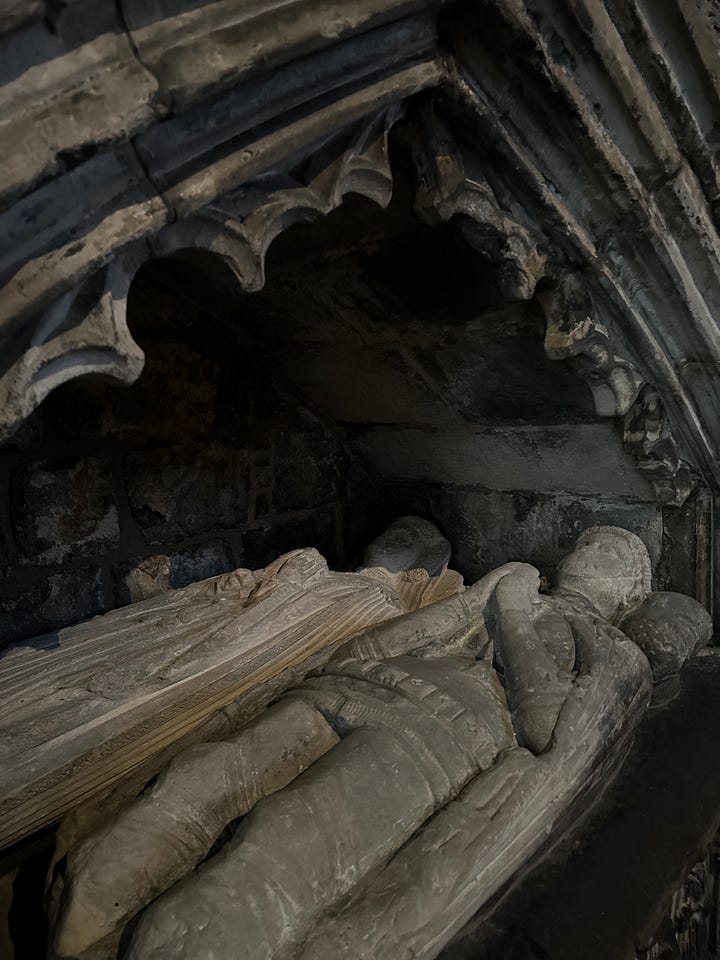

As the second son of Archibald ‘the Grim’ and Joanna Murray, James was never intended to be Earl of Douglas. That role fell to his older brother, Archibald (see last week’s newsletter for more information about this chap). This meant that for the vast majority of his life, James had the powerful Black Douglas name and connections but not the authority, assigning him to a career as an adherent to his older brother. James expertly adapted to this role and was a man whose upward career trajectory can be defined by his ability to play the loyal adherent to various parties and capitalise on the downfall of others. Was he a crooked politician who ruthlessly and effectively played the game, or a second son who regularly happened to be in the right place at the right time?
Long before the zenith of his career in becoming earl of Douglas in 1440, James’ authority was largely based in Lothian. The absence of a king from 1406 to 1424 allowed ambitious noblemen like James to increase their power, particularly on a regional basis. After a brief stint as the head of the Black Douglases from 1402 to 1408 while his elder brother was imprisoned in England, James turned his attention away from the Douglas heartlands of the south west. Taking advantage of his family’s unassailable power, James terrorised the Lothians without consequence. Burgh records of James forcibly seizing goods and money, in addition to imprisoning those who dared to defy him, are testament of his tyranny and thirst for power.
However, his actions did provide him with enemies in Lothian. In the early 1420s, James was forced to confront this problem and stabilise his position in this region, possibly in anticipation of the growing likelihood of the return of a king to Scotland, which would occur in 1424.
In 1423, James married Beatrice Sinclair, the daughter of the powerful William Sinclair, Earl of Orkney. William was an influential magnate in Lothian with a vast network of allies; just the kind of individual that James sought to ingratiate himself with. James’ marriage to Beatrice solidified James’ position as a legitimate lord in Lothian, smoothing over the unpleasant creases of the previous decade and more, whilst securing James a powerful relation that was not his Black Douglas kin. The significance of this union and Beatrice’s importance in James’ rise to power is symbolised in their magnificent double tomb in St Bride’s Church.
The following year held two defining events for James and his wider Black Douglas kin: the return of King James I in spring 1424 after 18 years in English captivity and the death of Archibald Douglas, 4th Earl of Douglas, at the Battle of Verneuil in France in August 1424. James I’s return signalled the renewal of royal authority in Scotland, while the 4th Earl’s death in France had a detrimental impact on the power of the Black Douglases as regional magnates in Scotland. The new 5th Earl of Douglas was James ‘the Gross’ Douglas’ nephew, the son and namesake of the late 4th Earl. He inherited the disastrous consequences of his father’s death in battle. The Black Douglas military might was the justification for the immense power of the Black Douglas earls in Scotland, and its destruction at Verneuil with the 4th Earl resulted in a huge loss of power for the new 5th Earl (see last week’s newsletter for more on this).
For James ‘the Gross’ Douglas, this was an opportunity. Rather than aligning himself with his nephew, he instead turned his attention to the recently returned James I of Scotland. While James I set out to achieve many things during his reign (I will not debate his success or failure in doing so today), one primary aim was the reduction in power of major regional magnates like the Black Douglases and the reinstatement of ultimate royal authority. From 1424 to 1437, Archibald Douglas, 5th Earl of Douglas, struggled under the weight of James I’s royal interference and cap on power, while James ‘the Gross’ Douglas flourished as a loyal adherent to the king and member of the royal clique of Lothian lords.
This was all to change. On the night of February 20th 1437, James I of Scotland was assassinated. The king had been unpopular in several ways, but his interference in the authority of regional lords was surely the primary motivation for his murder. His death and the succession of the six-year-old James II to the throne was a remarkable turn of events for Archibald, 5th Earl of Douglas, who was chosen as lieutenant-general of Scotland until the new king was of age to rule.
One might expect that this new order had a negative effect on James ‘the Gross’ Douglas. However, he once again engaged in his extraordinary skill of adapting allegiances. In the absence of a ruling adult, the influence of regional magnates again became of the highest importance, and James found himself returning to that old adherence to his Black Douglas earl, now his nephew. By binding his own status to the renewing might of the 5th Earl, James ensured the survival of his own relentless pursuit of power. As he always managed to do, James got his way. In return for his support of the 5th Earl, now lieutenant-general of Scotland, he gained the prestigious appointment of Justiciar South of the Forth, and was elevated to the rank of earl by being made 1st Earl of Avondale.
James ‘the Gross’ Douglas’ final and arguably most ruthless gain was to come. On June 26th 1439, Archibald Douglas, 5th Earl of Douglas, 2nd Duke of Touraine and lieutenant-general of Scotland, suddenly died after contracting a fever. He left behind two young sons: fifteen-year-old William and his younger brother David. William was the recipient of the Black Douglas inheritance and the new 6th Earl of Douglas. His great-uncle, James ‘the Gross’ Douglas of Avondale, watched ever on.
The death of an adult Douglas earl and the continuing minority reign of James II created an even greater vacuum of power in Scotland, with the running of the kingdom now unsteadily shared between three main parties: William Crichton, Alexander Livingston, and James ‘the Gross’ himself. This set the stage for a particularly ugly event in Scottish history, which of course benefitted one individual in particular. James ‘the Gross’ Douglas.
In November 1440, a meeting was arranged between the young James II and the new Black Douglas earl. William Douglas, 6th Earl of Douglas, and his younger brother, David, travelled to Edinburgh Castle with their chaperon, Malcolm Fleming of Cumbernauld, where they enjoyed dinner with their king. Ten-year-old James II was said to have been delighted by the company of the young Douglas brothers.
During the meal, a black bull’s head was presented and placed on the table. This was a symbol of death.
The two young Douglases were suddenly seized under fabricated charges of treason, and were given a mock trial before being dragged out onto castle hill alongside their companion, Malcolm Fleming. A ten-year-old James II pleaded for their lives, but in vain. William Douglas, 6th Earl of Douglas, his twelve-year-old brother David, and Malcolm Fleming of Cumbernauld were all beheaded. This brutal event was dubbed the Black Dinner, and remains one of many irremovable stains on Scotland’s history.
The lack of evidence around this event means we cannot absolutely find the guilty party who engineered this spectacular display of violence. William Crichton can certainly be accused, as he was Lord Chancellor of Scotland and Keeper of Edinburgh Castle at the time, meaning the young king was in his custody.
However, as he had always managed to do, James ‘the Gross’ Douglas capitalised from this situation, becoming 7th Earl of Douglas and the successor of the Black Douglas legacy. It is very difficult not to equate this ultimate climax of power with the callous murder of his two great-nephews. When we look at James’ life, it almost appears that he was waiting in the wings the entire time for this opportunity. James managed to avoid the difficulties of being the Black Douglas earl while building his own power base elsewhere, before sweeping in for the prize. Ultimately, James ‘the Gross’ Douglas was the second son who took it all through his voracious appetite for power.
James and Beatrice’s tomb at St Bride’s is evidence of a man—or indeed, a couple—of ultimate ambition. In addition to the symbolism of the double effigies of James and Beatrice, the tomb contains details that are an incredible display of Sinclair and Black Douglas emblems. The military might of the Black Douglases is invoked through the decorative helm which tops the tomb, while shields emblazoned with the heraldry of both families can be found several times. The sheer quality and detail of the entire structure is also testament to the wealth and power of James ‘the Gross’ Douglas and Beatrice Sinclair, at the time of his death in 1443.
For me, the strongest indication of James’ unwavering ambition for dynastic glory is found in the details of the box section of the tomb. Ten figures are carved in a line, separated unsymmetrically by a heraldic shield of Black Douglas and Sinclair. The four figures to the right of the shield are dressed in the garments and headdresses of 15th-century noblewomen; the six figures to the left are dressed as male nobles. These are the ten children of Beatrice Sinclair and James ‘the Gross’ Douglas, immortalised as mourners on their parents’ magnificent tomb. Six sons and four daughters, all of whom were clearly valued by their parents as continuing symbols of Black Douglas dynastic power.
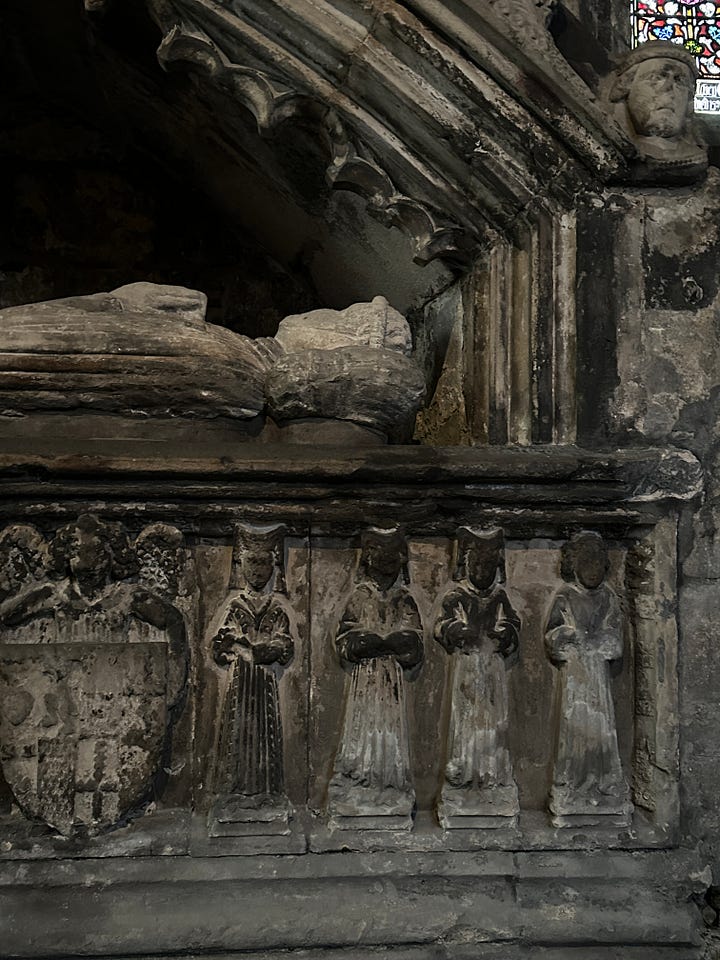

James ‘the Gross’ surely died rather pleased with himself and the Black Douglas empire that he had inherited through sheer ruthless ambition. Perhaps he envisioned that the dynasty he had created with Beatrice Sinclair would go from strength to strength, that he and his sons would be remembered as mighty Black Douglas earls on par with his ancestor, James ‘the Black’ Douglas. He could not have foreseen that his heir would be murdered by James II of Scotland in 1452, nor that his remaining sons would nearly all be killed or executed in a rebellion against the king in 1455 that would ultimately destroy the might of the Black Douglases once and for all.
Thank you so much for joining me on this mini-series about the Black Douglas tombs of St Bride’s Church! I hope that you have enjoyed reading and learning about them, just as much as I have writing. They are a truly fascinating family and understandably the inspiration for characters in many a fantasy novel. They almost inspire me to write one of my own! Now there’s an idea…
I’d like to quickly point out that while St Bride’s contains only the three Black Douglas tombs that we have explored, there were other crucial figureheads of this dynasty whose tombs from across Scotland have been lost to time, but no doubt held the same aura. These include:
Sir Archibald Douglas and Hugh ‘the Dull Douglas’, brothers of James ‘the Black’ Douglas
William Douglas, 1st Earl of Douglas (founder of Tantallon Castle and the Red Douglas line)
Sir William Douglas of Liddesdale
James Douglas, 2nd Earl of Douglas and the tragic hero of Otterburn
Archibald ‘the Grim’, bastard son of James ‘the Black’ Douglas and worthy of a book in his own right
Archibald ‘the Tyneman’ Douglas, 4th Earl of Douglas and 1st Duke of Touraine
This same situation unfortunately goes for the majority of the influential elite women who were daughters of or married into this family. Many of these women were similar to Beatrice Sinclair in being instrumental tools of territorial and dynastic gain. We cannot appreciate the power and legacy of the Black Douglases without them. They include:
Joanna Murray, Countess of Douglas, Lady of Galloway, Bothwell, and Drumsergard and the very key to the success of Archibald ‘the Grim’
Margaret of Mar, Countess of Douglas
Isabella, Countess of Douglas and Mar
Margaret Stewart, Countess of Angus
Princess Margaret Stewart
Euphemia Graham
Margaret, Fair Maid of Galloway
Thank you again, and I’ll see you next week for more Scottish history!
Beth xx




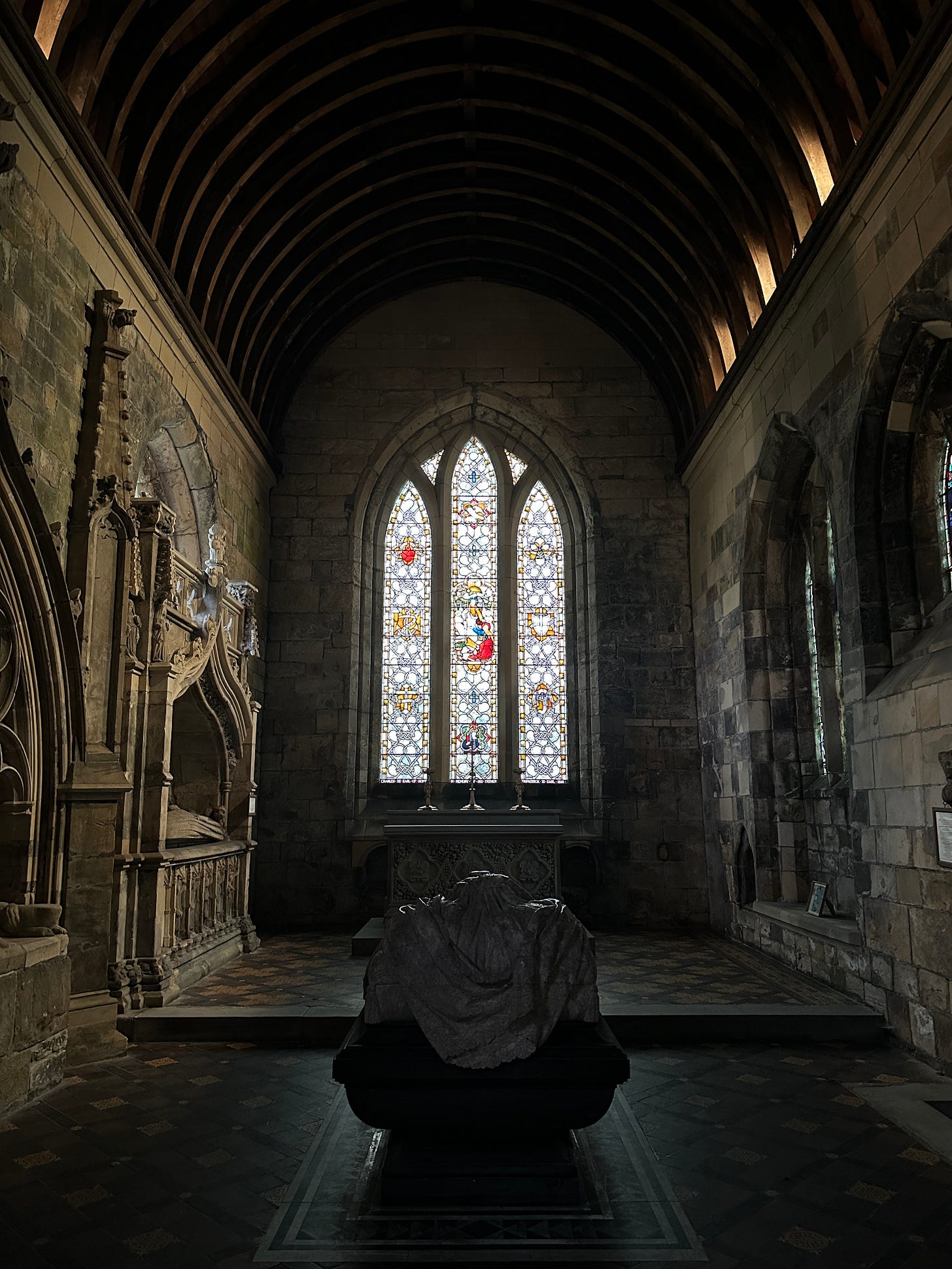
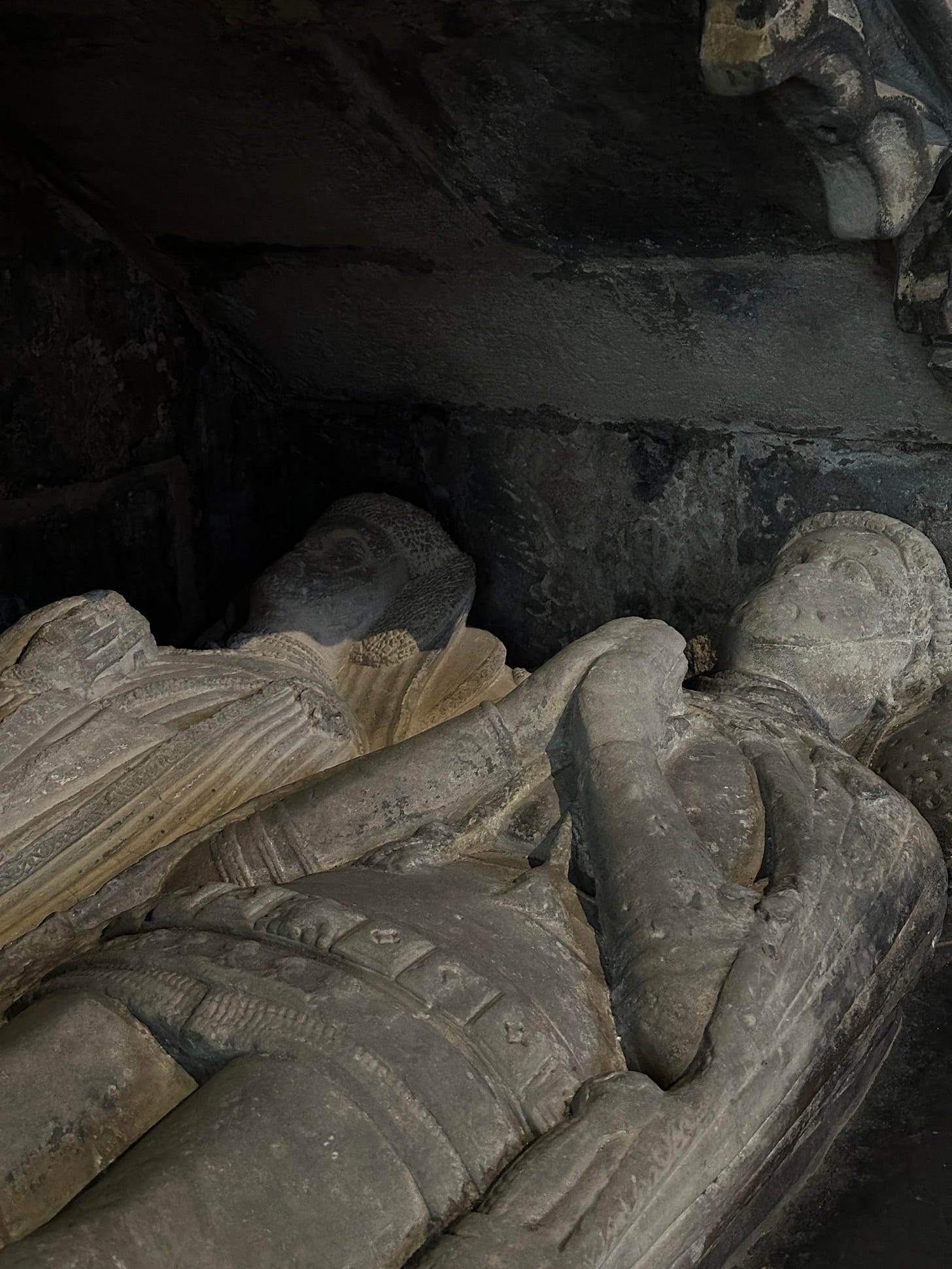
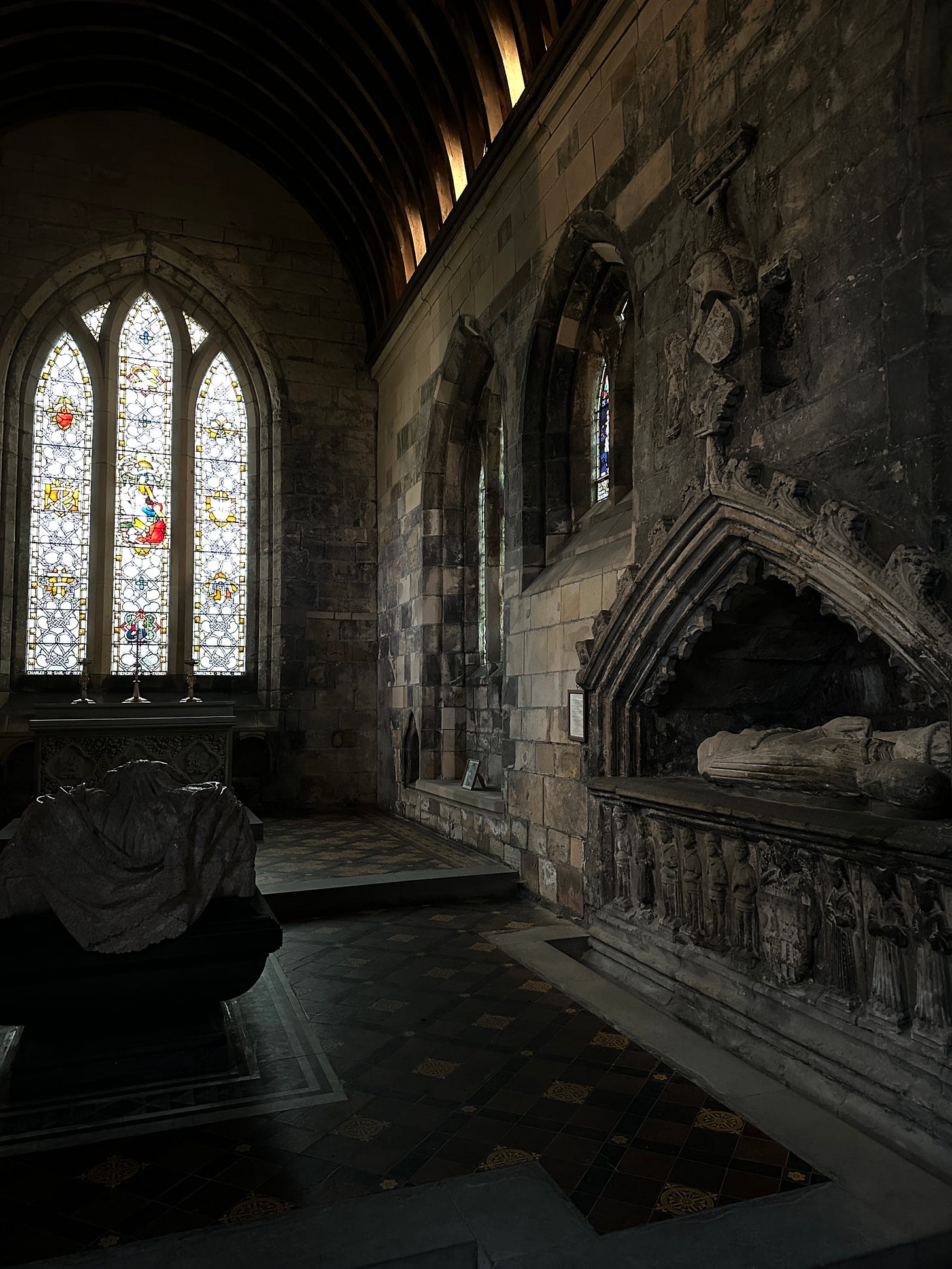

Well, that was quite the tale! What a series. Well done!
Amazing colourful characters that are worthy of books, movies, or tv series so that a wider audience can explore Scottish history. Thank you for reigniting my interest.